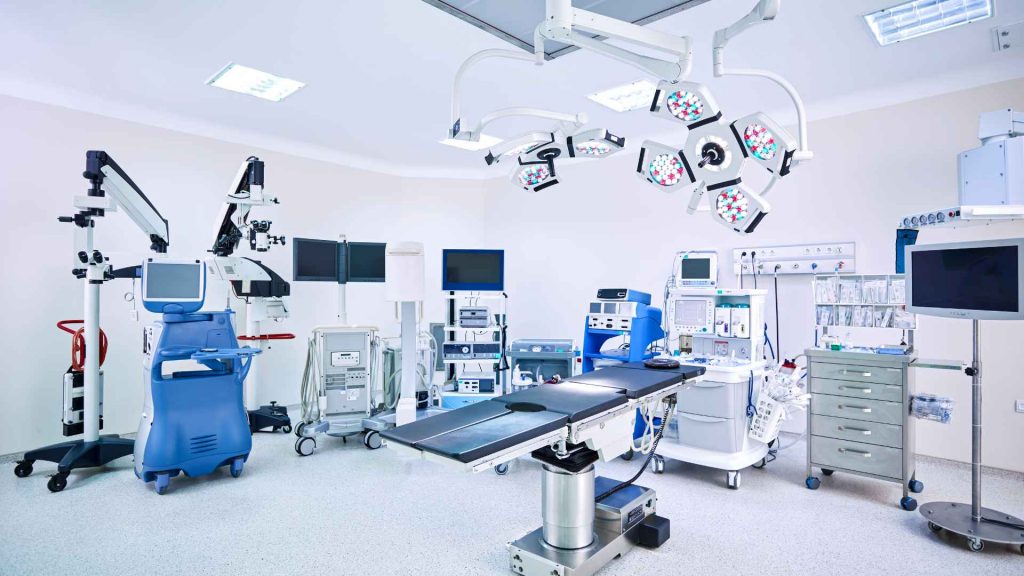Navigating the world of operating rooms can be like unraveling a complex puzzle. With a variety of types designed for specific surgical needs, it’s essential to understand the nuances that make each OR unique. From the precise environment of a sterile operating suite to the advanced integration of digital technology, the landscape of surgical spaces is as diverse as the procedures they host.
In our experience, the categorization of operating rooms is not just a matter of size or equipment. It reflects the meticulous planning that goes into ensuring patient safety and surgical efficiency. Whether it’s a Type I room bustling with the day’s scheduled surgeries or a Type IV room reserved for the most intricate cases, each plays a pivotal role in healthcare delivery. Let’s dive into the distinct types of operating rooms and the critical functions they serve in the medical world.

Type I Operating Rooms
When discussing what were the types of operating rooms, Type I facilities stand out as fundamental components of any hospital’s surgical suite. They’re tailored for scheduled surgeries that don’t require the complex apparatus necessary for more intricate procedures. I’ve learned that this type of operating room is designed with routine surgeries in mind, yet they maintain the essential characteristics required in any sterile surgical environment.
Type I operating rooms are typically more abundant than their specialized counterparts. In these rooms, surgeons perform a wide variety of surgeries, from minor to moderately complex procedures. One of the distinguishing features is the operating table. It’s versatile, allowing for adjustments and rotations throughout the surgery, ensuring that surgeons and medical teams can maintain optimal ergonomics. Tables come with specific weight restrictions and support pieces can be added or removed to allow for patient-specific modifications.
Another crucial aspect is the air quality and circulation in Type I operating rooms. The air should be sterile and clean to reduce the risk of post-operative infections. Many of these rooms are connected to a sluice, which maintains an optimal airflow in and out of the OR complex. This design is crucial for infection prevention – a cornerstone in patient safety protocols.
Regarding the interior layout, Type I operating rooms come equipped with the necessary monitoring devices to track patient vitals during surgery which are strategically placed so as not to obstruct the surgical team. The seamless integration of this equipment into the surgical workflow is of utmost importance, as it contributes to the efficiency and safety of the procedure.
These standard operating rooms are integral to healthcare delivery, often serving as the backbone to a hospital’s ability to provide surgical care. They’re outfitted with change rooms, supply storage, and dedicated areas for the preparation of sterile tools, reflecting meticulous planning that prioritizes patient safety and surgical success.
Type II Operating Rooms
When uncovering what were the types of operating rooms, Type II operating rooms stand out for their specialized design. Unlike Type I Operating Rooms which are versatile, Type II rooms are tailored for more complex procedures that demand a range of specific equipment and technological integrations.
In our experience, Type II rooms are often designated for surgeries within departments such as pediatric cardiovascular, gall bladder, gynecology, and plastic surgery. The evolution of operating room technology has been especially influential in these environments. The advancements from simple video routing systems in the 90s to now feature-packed rooms where video, audio, patient information, and building automation systems communicate seamlessly have vastly improved surgical outcomes.
The integration and communication between surgical lights, room lights, and specialized imaging devices are pivotal. The precision and focus required during intricate surgeries necessitate that all equipment operates in a coordinated manner, creating a safer and more controlled operative setting.
Efficiency and safety in Type II operating rooms are significant as we observe their impact on medical procedures and patient health. The layout and technology in these rooms aim to not just facilitate complex surgeries but also to reduce postoperative infections, a crucial aspect of patient care post-surgery.
- General Operating Room
- Neuro Operating Room
- Urology Operating Room
- Cardiac Thoracic Operating Room
- Spine Operating Room
- Orthopedic Operating Room
Each of these specialized operating rooms aligns with the part of the hospital it serves. They have essential equipment that streamlines procedures and enhances patient safety. The significance of these rooms is immeasurable, and their operation within a hospital’s ecosystem is vital to delivering comprehensive healthcare.

Type III Operating Rooms
As a healthcare writer, we’ve explored the ever-evolving landscape of surgical environments. Among them, Type III operating rooms stand out. Adaptability is key; these rooms are engineered to cater to a broad range of medical specialties. They’re not quite as complex as the Type II rooms, which are rigged with sophisticated tech for intricate procedures. Yet, they provide more flexibility than the standard Type I.
In these multipurpose spaces, surgeries may not demand the high-level integration seen in more specialized settings, but access to advanced equipment is still a priority. In Type III operating rooms, standardization is balanced with the versatility to accommodate different medical departments, whether it’s A or F. These dynamic environments can fluctuate daily in their operation schedules.
Let’s talk about capacity. Unlike departments with dedicated operating rooms, Type III settings must efficiently manage time and resources. The hospital’s weekly schedule is crucial to understand the demand for Type III rooms. This level of organization ensures that patient care is as seamless as possible and that surgeons can perform without delays.
The operating room technology used in Type III settings might include integrated systems that allow for real-time video and audio communication. They perhaps aren’t as all-encompassing as what you’d find in a Type II room, but they’re a far cry from the simplicity of past decades when video routing systems were a novel introduction.
Surgeons operating in these rooms appreciate their functionality that supports a wide range of procedures, from gynecology to plastic surgery. The focus here is to create an environment that is both safe and streamlined, trimming down the factors that could contribute to postoperative infections or procedural inefficiencies.
Understanding the unique characteristics of Type III operating rooms underlines their role in a hospital’s mission to provide comprehensive healthcare. These spaces are carefully designed to adapt to the needs of multiple specialties, reflecting a commitment to patient care and surgical success without the need for high levels of specialization.
Type IV Operating Rooms
In our experience of covering medical facilities, Type IV operating rooms (ORs) represent the pinnacle of surgical innovation and versatility. These ORs are typically utilized for complex, high-acuity procedures that demand state-of-the-art technology and maximum flexibility. While Type III ORs are valued for their adaptability across various medical specialties, Type IV rooms are often tailored to accommodate the specific requirements of intricate surgeries like cardiovascular, neurology, and orthopedics.
our investigation into the functionality of Type IV ORs reveals their critical role in optimizing patient outcomes. These cutting-edge spaces are equipped with advanced integration systems, ensuring seamless communication between video, audio, and building automation. This integration extends to patient information systems and specialized equipment, which might include high-definition imaging devices. It all started in the late ’90s with video routing systems, and today, these ORs exemplify the evolution of surgical environments.
It’s not just about flashy tech; the design of a Type IV operating room also significantly influences the prevention of postoperative infections. The emphasis on sterility and controlled conditions cannot be overstated. These rooms are often the chosen battleground for fighting complex medical conditions that demand the highest level of care, with each aspect meticulously engineered to support superior clinical outcomes.
When we talk about the types of ORs available, it’s essential to note that a Type IV room is not bound to just a single specialty. General surgery, cardiac and thoracic procedures, neurology, urology, and others may all take place within these walls. Such flexibility is vital because medical teams must rapidly respond to varying demands and patient needs.
Let’s look at the allocation of Type IV ORs in practice:
With their unmatched sophistication, Type IV ORs are a testament to how far medical technology has progressed. The surgical teams that operate in these rooms are highly skilled professionals who fully leverage the technological aids at hand to deliver exceptional care. As these rooms continue to evolve, they’ll undoubtedly set new standards for what’s possible in surgical care and patient safety.
Conclusion
Exploring the evolution of operating rooms has shown us the remarkable advancements in surgical environments. Type IV operating rooms stand out as the epitome of modern surgery, where technology and design converge to support complex procedures with unparalleled precision.
As we’ve delved into the various operating room types, it’s become clear that the future of surgical care is bright, with innovative spaces like these leading the charge. They’re not just rooms; they’re the heart of life-saving operations, pulsing with the rhythm of medical progress. It’s an exciting time in the world of surgery, and we’re eager to see how these developments continue to reshape patient outcomes and healthcare as a whole.
In conclusion, understanding the different types of operating rooms is crucial for optimizing patient outcomes and ensuring efficient surgical processes.
Each type of operating room, from general surgery suites to specialized hybrid operating rooms, plays a vital role in addressing the diverse and complex needs of modern healthcare. By leveraging advanced technology and maintaining stringent standards, these environments not only enhance the precision and safety of surgical procedures but also support the continuous evolution of medical practices.
As healthcare continues to advance, the significance of well-designed and appropriately equipped operating rooms will only become more pronounced, underscoring the need for ongoing innovation and adaptation in this critical aspect of medical care.





